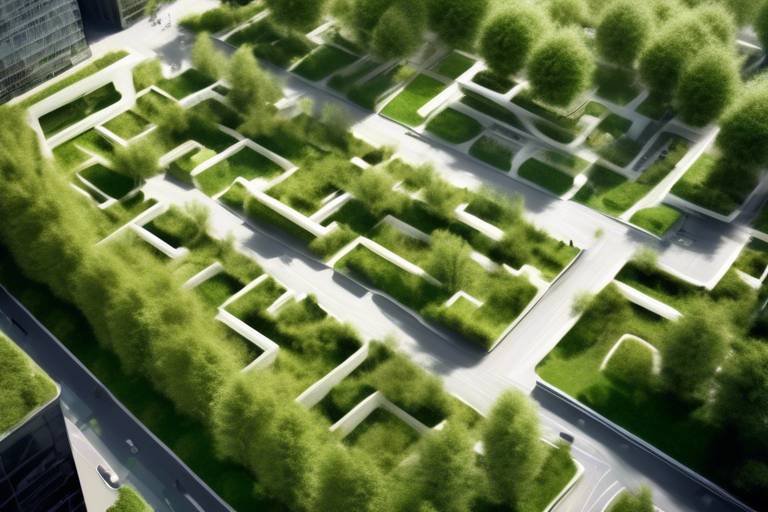How to Create a Sustainable Outdoor Living Area
Creating a sustainable outdoor living area is not just about designing a beautiful space, but also about making choices that benefit the environment and promote harmony with nature. By incorporating eco-friendly practices and materials, you can transform your outdoor space into a green oasis that supports biodiversity and reduces your ecological footprint.

Choosing Eco-Friendly Materials
When it comes to creating a sustainable outdoor living area, one of the key factors to consider is choosing eco-friendly materials. By selecting materials that have minimal impact on the environment, you can contribute to a greener and more harmonious outdoor space. Sustainable materials such as reclaimed wood, bamboo, and recycled plastic are excellent choices for furniture and structures in your outdoor area.
Reclaimed wood not only adds a rustic and unique charm to your outdoor space but also helps reduce the demand for new timber, thus conserving forests. Bamboo, known for its rapid growth and renewability, is a durable and versatile material that can be used for various outdoor furniture pieces. Additionally, opting for furniture made from recycled plastic helps divert plastic waste from landfills and oceans, giving it a new life in your outdoor living area.
When selecting eco-friendly materials, it's essential to consider not only their sustainability but also their durability and suitability for outdoor use. By choosing materials that can withstand the elements and require minimal maintenance, you can create a long-lasting and environmentally conscious outdoor space.

Water Conservation Strategies
Tips and ideas for designing an eco-friendly outdoor space that promotes sustainability and harmony with nature.
When it comes to creating a sustainable outdoor living area, water conservation plays a crucial role in reducing environmental impact and promoting eco-friendliness. Implementing water-saving techniques such as drip irrigation, rainwater harvesting, and drought-resistant landscaping can significantly minimize water usage while maintaining a lush and vibrant outdoor space.
By incorporating a drip irrigation system, you can ensure that water is delivered directly to the roots of plants, minimizing evaporation and runoff. This targeted approach not only conserves water but also promotes healthier plant growth. Additionally, rainwater harvesting allows you to collect and store rainwater for future use in watering your garden, reducing the reliance on municipal water sources.
Choosing drought-resistant plants for your landscaping not only adds beauty to your outdoor space but also requires less water to thrive. Native plants are well-adapted to the local climate and soil conditions, making them an excellent choice for sustainable landscaping. These plants can withstand dry periods and require minimal irrigation, contributing to water conservation efforts.
Furthermore, incorporating mulch in your garden beds can help retain moisture in the soil, reducing the frequency of watering. Mulch acts as a natural barrier, preventing water evaporation and weed growth while insulating plant roots from extreme temperatures. This simple yet effective strategy can significantly improve water efficiency in your outdoor living area.
By adopting these water conservation strategies, you can create a sustainable outdoor space that not only conserves water but also thrives in harmony with nature.

Energy-Efficient Lighting
Tips and ideas for designing an eco-friendly outdoor space that promotes sustainability and harmony with nature.
When it comes to creating a sustainable outdoor living area, lighting plays a crucial role in not only enhancing the ambiance but also reducing energy consumption. By opting for solar-powered lights, you can harness the power of the sun to illuminate your outdoor space without relying on traditional electricity sources. These lights are not only energy-efficient but also cost-effective in the long run, saving you money on utility bills.
Another eco-friendly lighting option is LED fixtures. LED lights are known for their energy efficiency and durability, lasting much longer than traditional incandescent bulbs. By using LED fixtures in your outdoor area, you can significantly reduce energy consumption while still enjoying bright and vibrant lighting.
To further enhance the energy efficiency of your outdoor space, consider incorporating motion sensors into your lighting design. These sensors detect movement and automatically turn on the lights, helping to conserve energy by only illuminating the area when needed. Not only does this reduce energy waste, but it also adds a layer of security to your outdoor living area.
By combining solar-powered lights, LED fixtures, and motion sensors, you can create an eco-friendly ambiance in your outdoor space while minimizing energy consumption and reducing your environmental footprint.
Do you have to compromise on aesthetics when choosing energy-efficient lighting for your outdoor living area?
What are the benefits of using motion sensors in outdoor lighting?
How can solar-powered lights contribute to sustainability in outdoor spaces?

Native Plant Landscaping
When it comes to creating a sustainable outdoor living area, one crucial aspect to consider is . By incorporating plants that are indigenous to your region, you can significantly reduce water consumption, maintenance needs, and support the local ecosystem.
Native plants are well-adapted to the local climate and soil conditions, requiring minimal watering once established. This not only helps conserve water but also reduces the need for irrigation systems, saving both resources and money in the long run. Additionally, these plants attract local wildlife such as birds, bees, and butterflies, contributing to the biodiversity of your outdoor space.
One of the key benefits of native plant landscaping is the preservation of the natural beauty of the area. These plants offer a sense of authenticity and harmony with the surrounding environment, creating a seamless transition between your outdoor living space and the native landscape. Moreover, native plants are often more resilient to pests and diseases, reducing the need for chemical pesticides and fertilizers that can harm the environment.
When selecting native plants for your outdoor area, consider factors such as sunlight exposure, soil type, and water availability to ensure their successful growth. By creating a diverse plant palette with a mix of flowers, shrubs, and trees, you can enhance the visual appeal of your outdoor space while supporting the local ecosystem.
Incorporating native plant landscaping into your outdoor design not only promotes sustainability but also fosters a deeper connection with nature. Imagine stepping outside into a garden filled with vibrant blooms, buzzing pollinators, and the soothing sounds of birds—all thanks to the thoughtful selection of native plants that thrive in your region.

Composting and Waste Management
Composting and waste management are essential components of creating a sustainable outdoor living area. By setting up a composting system, you can turn organic waste into nutrient-rich soil for your garden. This not only reduces the amount of waste that ends up in landfills but also provides a natural fertilizer for your plants, promoting a healthy ecosystem.
Recycling bins are another crucial element of waste management in an eco-friendly outdoor space. By separating recyclable materials from general waste, you can ensure that items like plastic, glass, and paper are properly recycled, reducing the overall environmental impact of your outdoor area.
Proper waste disposal methods are also vital for maintaining a sustainable outdoor environment. This includes disposing of hazardous materials responsibly, such as batteries and electronics, to prevent pollution and harm to local wildlife. By incorporating these waste management practices, you can minimize your carbon footprint and contribute to a cleaner, healthier planet.

Green Roof and Vertical Gardens
Green roofs and vertical gardens are innovative ways to enhance the sustainability and visual appeal of outdoor living areas. Green roofs involve covering the top of a structure with vegetation, providing insulation, reducing heat absorption, and improving air quality. On the other hand, vertical gardens utilize vertical spaces to grow plants, creating a lush and vibrant environment.
These eco-friendly features offer numerous benefits beyond their aesthetic value. Green roofs, for example, help reduce energy costs by providing natural insulation, lowering indoor temperatures in summer, and reducing heat loss in winter. They also mitigate the urban heat island effect by absorbing sunlight and releasing moisture through transpiration.
Vertical gardens, also known as living walls, not only add a touch of greenery to limited outdoor spaces but also act as natural air filters, absorbing pollutants and releasing oxygen. They can be customized to suit different styles and preferences, from cascading foliage to colorful flowering plants, adding a dynamic element to the outdoor environment.
Moreover, both green roofs and vertical gardens promote biodiversity by creating habitats for insects, birds, and other wildlife. They contribute to urban greening efforts, offsetting the loss of green spaces in densely populated areas and fostering a connection to nature in urban settings.
When incorporating green roofs and vertical gardens into outdoor living spaces, careful planning and maintenance are essential. Proper irrigation systems, soil composition, and plant selection play a crucial role in ensuring the longevity and vitality of these green features. Additionally, regular monitoring and upkeep are necessary to address any issues and promote healthy growth.

DIY Upcycling Projects
DIY upcycling projects are a fantastic way to add a personal touch to your sustainable outdoor living area. By repurposing old items into new decor, furniture, and planters, you not only reduce waste but also create unique pieces that reflect your creativity and style. Upcycling can range from simple projects like turning old tires into planters to more complex endeavors like transforming wooden pallets into outdoor furniture.
One popular upcycling project is creating a herb garden from recycled tin cans. By painting and decorating the cans, you can add a pop of color to your outdoor space while also growing fresh herbs for cooking. Another creative idea is to repurpose old wooden crates into shelving units for displaying potted plants or outdoor decor.
If you're feeling crafty, you can try making outdoor lighting fixtures from mason jars or wine bottles. These unique lighting elements not only illuminate your outdoor area but also add a touch of whimsy and charm. Additionally, transforming an old ladder into a vertical garden is a great way to maximize space and create a striking visual feature in your outdoor oasis.
Upcycling projects not only contribute to the sustainability of your outdoor living area but also serve as conversation starters and focal points. By incorporating these DIY projects into your outdoor space, you can showcase your commitment to eco-conscious living while infusing your personal flair into every corner of your outdoor sanctuary.

Outdoor Sustainable Practices
When it comes to maintaining a sustainable outdoor living area, there are several eco-friendly practices that can be easily incorporated into your daily routine. One key aspect is the use of non-toxic cleaning products to keep your outdoor space clean without harming the environment. By opting for natural and biodegradable cleaners, you can reduce chemical runoff and protect local ecosystems.
Another important practice is energy conservation. By being mindful of energy usage in your outdoor area, such as turning off lights when not in use and using energy-efficient appliances, you can lower your carbon footprint and contribute to a greener environment. Additionally, consider installing solar-powered outdoor lights to harness the power of the sun and illuminate your space sustainably.
Supporting local wildlife is also a crucial aspect of outdoor sustainability. By providing bird feeders, bird baths, and native plantings, you can create a welcoming habitat for birds, butterflies, and other beneficial creatures. This not only adds to the biodiversity of your outdoor space but also helps in maintaining a balanced ecosystem.
Furthermore, practicing water conservation is essential for a sustainable outdoor living area. Implementing rainwater harvesting systems can help capture and store rainwater for irrigation purposes, reducing the need for municipal water sources. Additionally, using drought-tolerant plants and mulching can minimize water usage and promote healthy plant growth without excessive watering.
When it comes to waste management, setting up recycling bins and a composting system is key to reducing landfill waste and creating nutrient-rich soil for your garden. By segregating and recycling waste materials, you can contribute to a circular economy and minimize the environmental impact of your outdoor activities.
Lastly, engaging in environmentally conscious landscaping practices such as mulching, companion planting, and organic pest control can help maintain a healthy and vibrant outdoor space without relying on harmful chemicals. By working in harmony with nature and adopting sustainable practices, you can create a beautiful and eco-friendly outdoor living area that benefits both you and the environment.
Frequently Asked Questions
- What are the benefits of using eco-friendly materials in an outdoor living area?
Using eco-friendly materials such as reclaimed wood, bamboo, and recycled plastic helps reduce environmental impact by promoting sustainability and reducing the depletion of natural resources. These materials also tend to have a lower carbon footprint compared to traditional materials, contributing to a healthier outdoor environment.
- How can water conservation strategies be implemented in an outdoor space?
Water conservation in an outdoor living area can be achieved through practices like drip irrigation, rainwater harvesting, and planting drought-resistant landscaping. These techniques help minimize water usage, reduce water bills, and support the overall sustainability of the outdoor space.
- Why is native plant landscaping important for creating a sustainable outdoor area?
Native plant landscaping is crucial for sustainability as these plants are well-adapted to the local climate and require less water and maintenance. Additionally, they support local wildlife, enhance biodiversity, and contribute to the overall beauty and harmony of the outdoor space.
- How can composting and waste management contribute to a sustainable outdoor environment?
Implementing a composting system, recycling bins, and proper waste disposal methods in an outdoor area can significantly reduce landfill waste, minimize greenhouse gas emissions, and promote soil health through the production of nutrient-rich compost. This helps create a more sustainable and eco-friendly outdoor living space.
- What are the advantages of installing a green roof or vertical garden in an outdoor space?
Green roofs and vertical gardens offer numerous benefits, including improved air quality, enhanced insulation for buildings, reduced urban heat island effect, and the creation of a visually appealing green space in limited outdoor areas. These features also support biodiversity and contribute to a healthier environment.



















